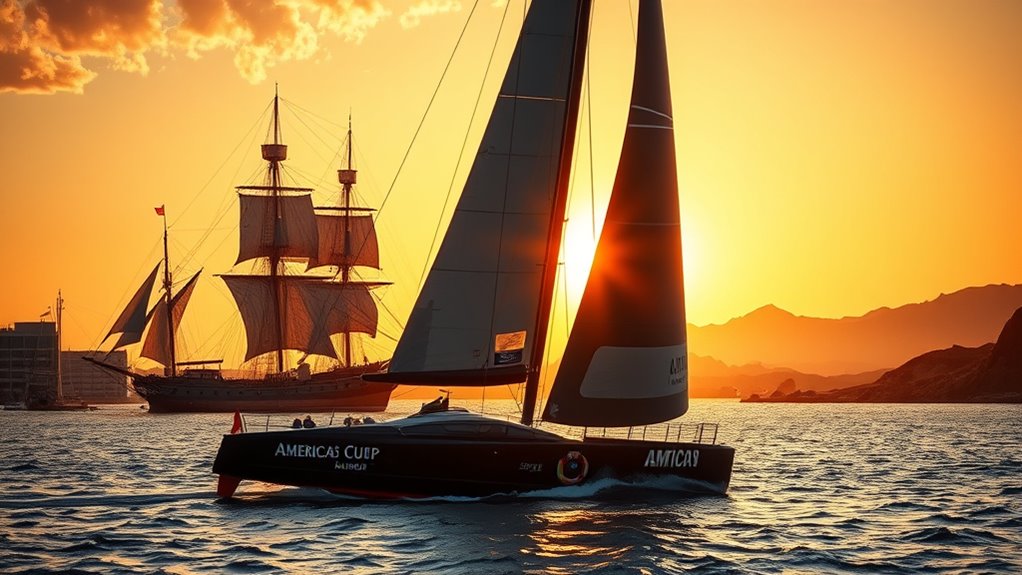The America’s Cup, rooted in 19th-century rivalry and innovation, has grown from a challenge after the Boston Tea Party into a symbol of technological mastery and national pride. It showcases the evolution of sailing from simple boats to cutting-edge vessels with hydrofoils and advanced materials. This fierce competition reveals strategies, breakthroughs, and fierce international rivalry, blending tradition with high-tech advancements. To discover how this iconic event connects history’s past with tomorrow’s technology, keep exploring.
Key Takeaways
- The America’s Cup originated in 1851, shortly after the Boston Tea Party, symbolizing American innovation and independence.
- The event’s evolution reflects America’s pioneering spirit, similar to westward expansion and frontier exploration.
- Technological advances in sailing mirror historical innovations during the American frontier and industrial eras.
- The rivalry highlights national pride, akin to the territorial disputes and competitions of the Wild West era.
- Both the Cup and westward expansion embody themes of exploration, competition, and technological progress in American history.

Have you ever wondered what makes the America’s Cup the oldest and most prestigious trophy in competitive sailing? It’s not just about the race itself; it’s about the innovation, the fierce international rivalry, and the relentless pursuit of perfection. Over the years, sailing technology has evolved dramatically, transforming the competition from simple wooden boats to cutting-edge, high-tech vessels that push the limits of physics and design. This constant drive for innovation keeps the America’s Cup at the forefront of sailing, attracting the brightest minds and the most advanced materials from around the world.
The America’s Cup combines innovation, fierce rivalry, and cutting-edge technology, making it the pinnacle of competitive sailing.
The rivalry that fuels the America’s Cup is unlike any other in sport. It’s an ongoing battle between nations, teams, and sailing philosophies, each enthusiastic to claim supremacy. Historically, countries like Britain, the United States, New Zealand, and Switzerland have gone head-to-head, each contest revealing new technological breakthroughs and strategic prowess. These competitions aren’t just about crossing the finish line first; they’re about outsmarting and outmaneuvering opponents with every tack, gybe, and maneuver. This international rivalry has historically driven innovation, making each edition of the Cup more spectacular and technologically advanced than the last.
Sailing technology, in particular, has played a pivotal role in shaping the Cup’s history. From the early days of heavy, wooden sloops to the modern, wing-sailed catamarans and foiling monohulls, each new vessel is a marvel of engineering. Advances like lightweight composites, hydrofoils that lift boats above the water, and computer-aided design have revolutionized how races are conducted. These innovations are not merely for show—they considerably improve speed, maneuverability, and efficiency. As a result, teams invest millions into R&D, sometimes even risking their entire campaigns on revolutionary ideas. The technological arms race underscores the seriousness of the competition and reflects the values of ingenuity and craftsmanship that define the America’s Cup. Moreover, offshore racing strategies and technologies continue to influence design choices, pushing the boundaries even further. Additionally, the integration of advanced materials ensures that vessels remain lightweight yet durable under extreme conditions.
From its origins, which trace back to a spirited challenge in 1851, the America’s Cup has always been about more than just sailing; it’s a symbol of national pride and technological mastery. The intense international rivalry and ongoing advancements in sailing technology have kept it relevant and exciting, drawing worldwide attention. Each race tells a story of innovation, strategy, and relentless ambition, making it clear why the America’s Cup remains the pinnacle of competitive sailing. It’s a tradition rooted in history, yet always pushing forward into the future.
Frequently Asked Questions
How Did the America’S Cup Influence U.S. Maritime Laws?
You might not realize it, but the America’s Cup substantially influenced U.S. maritime laws by setting legal precedents that emphasize maritime safety and fair competition. As you follow the race, you see how regulations evolved to guarantee safety standards for sailors and enforce international rules. These developments shaped broader maritime laws, reinforcing safety protocols and legal standards that protect those steering U.S. waters and foster competitive fairness.
What Were the Key Technological Innovations in America’S Cup History?
Imagine a race where every wave and gust pushes sailboat design to its limits. You see, the America’s Cup pushed innovation with cutting-edge sailboat design and advanced navigation technology. These innovations transformed racing, making boats faster and more agile. From wing sails to hydrofoils, each breakthrough redefined what’s possible on the water, turning competitors into pioneers and setting new standards for maritime excellence.
How Has the Race Impacted Local Economies Along Its Routes?
You see, the race boosts local economies through economic development, attracting tourists and creating jobs. It also fosters cultural exchange, as spectators and teams from around the world gather, sharing traditions and knowledge. This influx of visitors stimulates businesses, hotels, and restaurants, leaving a lasting positive impact. Overall, the race’s route sparks growth and connections, making it a significant event that benefits communities culturally and economically.
What Role Did Piracy Play in Early America’S Cup Races?
Pirate interference played a significant role in early America’s Cup races, as maritime law was still developing. You’d see pirates threatening ships and disrupting race routes, forcing racers to be vigilant. These encounters prompted stricter enforcement of maritime law to protect vessels and ensure fair competition. Pirates challenged the safety and legality of early races, shaping the need for stronger naval presence and regulations to safeguard racers and promote secure maritime sport.
How Has America’S Cup Popularity Changed Over the Centuries?
Imagine a grand ship sailing through changing tides; your curiosity about America’s Cup’s popularity is no different. Over centuries, sailing traditions have evolved, but the event’s cultural significance remains a beacon for enthusiasts. Its popularity has waxed and waned, like the moon’s phases, yet it continues to inspire and unite people. Today, you see a storied legacy that’s grown more vibrant, preserving its importance in maritime history and sporting passion.
Conclusion
As you watch America’s Cup sail into the future, remember how history’s pioneers, like the Boston Tea Party rebels, dared to challenge the status quo. Just as they turned the tide against imperial control, today’s sailors push boundaries on the water, steering their vessels with innovation and daring. It’s a wild west of competition and courage, where every race is a new frontier. So, hold on tight—this race is far from over, and adventure awaits beyond the horizon.









